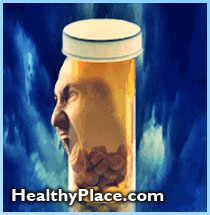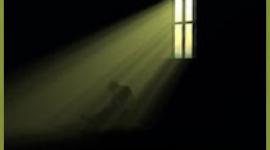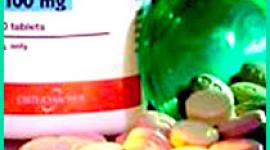Neuroleptic Malignant Syndrome (NMS)
Two potentially fatal side-effects of antipsychotic medications - NMS and Serotonin Syndrome. Could you recognize these psychiatric emergencies?
Virtually all antipsychotic drugs-and even some dopamine-blocking agents and antidepressants-carry the risk of a potentially fatal reaction. Your ability to recognize the symptoms and intervene quickly can save a patient's life. Two days after being admitted to the psychiatric ICU for an exacerbation of paranoid schizophrenia, 35-year-old Scott Thorp was still not improving. Not only did he continue to suffer psychotic symptoms, but he complained of feeling "extremely uneasy" and "jittery inside." Because Mr. Thorp was being treated with the high-potency antipsychotic drug haloperidol (Haldol), the staff conducted a routine assessment for extrapyramidal symptoms (EPS) and recognized his restless movements as akathisia-a common adverse effect of such medications-rather than illness-related agitation. The akathisia subsided after four doses of the anticholinergic agent benztropine mesylate (Cogentin) were administered over two days.
But on day 3, Mr. Thorp's condition worsened. He developed lead-pipe muscular rigidity with resistance of the upper extremities. His BP fluctuated wildly, and he was mildly tachycardic, with a pulse rate of 108/114. His nurse also noted tremulousness and, to her surprise, urinary incontinence.At shift change, his temperature was 101.4° F (38.5° C), he was confused, lethargic, and noticeably diaphoretic. The nurse looked again at the elevated temperature and began to suspect an adverse reaction to haloperidol-and she was right. Mr. Thorp had developed neuroleptic malignant syndrome (NMS), a rare but potentially life-threatening side effect of antipsychotic medications.1 Besides elevated temperature, Mr. Thorp had other signsautonomic dysfunction (which includes hypertension, tachycardia, urinary incontinence, and diaphoresis) and muscular rigidity-that are "red flags" for NMS. The nurse immediately contacted the attending psychiatrist, who ordered that haloperidol be discontinued and Mr. Thorp be transferred to the medical ICU.
There, lab results confirmed a diagnosis of NMS. They showed increased levels of lactic dehydrogenase (LDH), serum creatine phosphokinase (CPK), aspartate aminotransferase (AST), and alanine aminotransferase (ALT). Mr. Thorp's WBC count was also elevated-another lab finding that confirms NMS, in which WBC levels as high as 40,000/mm3 have been reported.2 Mr. Thorp's labs also revealed that he had become dehydrated and was hyperkalemic. His urinalysis revealed proteinuria and myoglobinuria, two signals of muscle deterioration and early indicators of renal insufficiency.
Recognizing the signs of NMS
 NMS is an extreme medical emergency. Although it occurs in no more than 1% of patients who take antipsychotic medications,1 NMS develops rapidly, and death occurs in about 10% of cases, largely because of the consequences of severe rigidity and dehydration, including acute renal failure, respiratory distress, and deep vein thrombosis.2,3 NMS is believed to be caused by an acute reduction in dopamine activity as a result of drug-induced dopamine blockade. It was first described in 1960 during early studies of haloperidol, but it can occur with virtually any antipsychotic medication. Although NMS was not originally thought to occur with newer "atypical" antipsychotics such as clozapine (Clozaril) and risperidone (Risperdal), the syndrome has been associated with both those agents as well as with lithium carbonate (Eskalith, Lithane, Lithobid) and with dopamine-blocking antiemetics such as metoclopramide (Reglan) and prochlorperazine (Compazine).1,2 NMS or NMS-like side effects may also occur with some antidepressants, such as monoamine oxidase inhibitors (MAOIs) and tricyclic antidepressants.2-4 Signs of NMS usually appear within two weeks after therapy is begun or the dosage of the medication is increased. Hyperthermia, severe muscular rigidity, autonomic instability, and changing levels of consciousness are the four major hallmarks.1,2 Temperatures of 101° F (38.3° C) to 103° F (39.4° C) are not uncommon, and, in some cases, rise as high as 108° F (42.2° C).3 The leadpipe rigidity of the upper extremities Mr. Thorp exhibited is the most common form of muscle rigidity, but the ratcheting movement of the joints known as cogwheeling is also seen; in addition, the muscular rigidity can affect the neck and chest, leading to respiratory distress. As seen with Mr. Thorp, rapid physical decline occurs over the course of two to three days. NMS may be difficult to recognize. It can occur along with a cluster of other extrapyramidal symptoms and has been associated with dystonia and parkinsonism. Many times akinesia, a generalized slowing of movement, with fatigue, blunted affect, and emotional unresponsiveness, is present rather than akathisia. Akinesia can easily be mistaken for the vegetative symptoms of a major depressive disorder. In addition, several disorders have symptoms similar to those of NMS, including catatonia, degenerative diseases of the brain, heat stroke, infections, and malignant hyperthermia.
NMS is an extreme medical emergency. Although it occurs in no more than 1% of patients who take antipsychotic medications,1 NMS develops rapidly, and death occurs in about 10% of cases, largely because of the consequences of severe rigidity and dehydration, including acute renal failure, respiratory distress, and deep vein thrombosis.2,3 NMS is believed to be caused by an acute reduction in dopamine activity as a result of drug-induced dopamine blockade. It was first described in 1960 during early studies of haloperidol, but it can occur with virtually any antipsychotic medication. Although NMS was not originally thought to occur with newer "atypical" antipsychotics such as clozapine (Clozaril) and risperidone (Risperdal), the syndrome has been associated with both those agents as well as with lithium carbonate (Eskalith, Lithane, Lithobid) and with dopamine-blocking antiemetics such as metoclopramide (Reglan) and prochlorperazine (Compazine).1,2 NMS or NMS-like side effects may also occur with some antidepressants, such as monoamine oxidase inhibitors (MAOIs) and tricyclic antidepressants.2-4 Signs of NMS usually appear within two weeks after therapy is begun or the dosage of the medication is increased. Hyperthermia, severe muscular rigidity, autonomic instability, and changing levels of consciousness are the four major hallmarks.1,2 Temperatures of 101° F (38.3° C) to 103° F (39.4° C) are not uncommon, and, in some cases, rise as high as 108° F (42.2° C).3 The leadpipe rigidity of the upper extremities Mr. Thorp exhibited is the most common form of muscle rigidity, but the ratcheting movement of the joints known as cogwheeling is also seen; in addition, the muscular rigidity can affect the neck and chest, leading to respiratory distress. As seen with Mr. Thorp, rapid physical decline occurs over the course of two to three days. NMS may be difficult to recognize. It can occur along with a cluster of other extrapyramidal symptoms and has been associated with dystonia and parkinsonism. Many times akinesia, a generalized slowing of movement, with fatigue, blunted affect, and emotional unresponsiveness, is present rather than akathisia. Akinesia can easily be mistaken for the vegetative symptoms of a major depressive disorder. In addition, several disorders have symptoms similar to those of NMS, including catatonia, degenerative diseases of the brain, heat stroke, infections, and malignant hyperthermia.
The rise in temperature caused by NMS could be mistaken for a sign of pneumonia or urinary tract infection. But symptoms of confusion, disorientation, muscle rigidity, and rapid change in temperature for no physiological reason should always trigger an evaluation of a patient's medications. Tachycardia, for example, can be a side effect of drugs like clozapine and chlorpromazine hydrochloride (Thorazine). Furthermore, high temperature, confusion, and disorientation are not usually seen with psychosis. Which patients are more likely to develop NMS? The syndrome occurs twice as often in men as in women, and patients who have had prior NMS episodes have a higher risk of recurrence.2 Certain medications, alone or in combination, and how they are administered increase the risk of NMS: rapid titration or high-dose administration of a neuroleptic, IM medications that form a deposit and are released over time (called a depot injection), use of high-potency neuroleptics like haloperidol and fluphenazine hydrochloride (Prolixin), lithium alone or in combination with an antipsychotic, and the combination of two or more neuroleptics. Exhaustion and dehydration put patients who are taking neuroleptics at higher risk of NMS, as do akinesia and organic brain disease. The syndrome also occurs more frequently in hot geographic regions.
Providing treatment and supportive care
Given its life-threatening complications, NMS calls for early recognition and immediate intervention. A psychiatrist or neurologist with expertise in NMS should be consulted at the first signs of this syndrome. The most critical intervention is to discontinue neuroleptic therapy. If the patient had received a long-acting depot injection, however, it may take as long as a month to bring symptoms under control. Medications that are most frequently used to treat the syndrome are bromocriptine mesylate (Parlodel), an antiparkinsonian dopaminergic drug; and dantrolene sodium (Dantrium), a muscle relaxant. As seen in Mr. Thorp's case, anticholinergics such as benztropine, while effective in the treatment of extrapyramidal symptoms, are not helpful in treating NMS. As medications are administered, be alert to potential toxicity or adverse effects. With dantrolene, there is an increased risk of liver toxicity as well as phlebitis at the IV site. You will also need to provide supportive care to control and reduce fever, treat secondary infections, and regulate vital signs and cardiac, respiratory, and renal function. Renal failure is treated with hemodialysis, as necessary. Since the patient may well become confused, determine whether additional safety measures are needed. Sedatives may also be called for. A change of position and decreased environmental stimulation may make the patient more comfortable. Understandably, NMS is painful and frightening for the patient and emotionally upsetting to the family. Make time to explain what has happened and why, and what the treatments are designed to do. With the measures described, NMS usually resolves in one or two weeks. The patient's level of consciousness should improve, and delirium and confusion should decrease. However, the patient's episode of psychosis may continue until after an antipsychotic medication can be reintroduced. You'll want to do frequent mental status assessments, monitor I & O, and evaluate lab results. Once the NMS symptoms are under control (and, ideally, not until two weeks after they've resolved), alternative antipsychotic medications should be explored. In some cases, it may be necessary to gradually reintroduce the original antipsychotic, a process called "rechallenge." Rechallenge should always begin with the lowest dose possible and then proceed with gradual upward titration. Because of the high risk that NMS will recur, however, monitor the patient closely for extrapyramidal symptoms and other side effects.
A new syndrome looks like NMS
Serotonin syndrome is another potentially fatal drug reaction that resembles NMS in its presentation. Until recently, it was described as NMS without the involvement of neuroleptics. Drug history is the most important factor for distinguishing between the two.(3) Whereas NMS results from the depletion of the neurotransmitter dopamine, serotonin syndrome results from excess levels of serotonin. Typically, the excess results from the combination of a serotonin-enhancing drug with an MAOI. For example, the syndrome could develop if a depressed patient on an MAOI is switched to a selective serotonin reuptake inhibitor (SSRI) such as fluoxetine (Prozac) without allowing a sufficient "washout" period for the MAOI to be eliminated from the body. Symptoms include hyperthermia as well as mental changes, muscle rigidity or exaggerated reflexes, autonomic instability, and seizures or pseudoseizures. Comprehensive assessment and early recognition of NMS and serotonin syndrome are critical to a positive outcome. The nurse who was quick to recognize Mr. Thorp's symptoms, for example, could literally have saved his life.
REFERENCES
1. Varcarolis, E. M. (1998). Schizophrenic disorders. In E. M. Varcarolis
(Ed.), Foundations of psychiatric mental health nursing (3rd ed.), (pp. 650 651). Philadelphia: W. B. Saunders.
2. Pelonero, A. L., & Levenson, J. L. (1998). Neuroleptic malignant syndrome: A review. Psychiatric Services, 49(9), 1163.
3. Keltner, N. L. (1997). Catastrophic consequences secondary to psychotropic drugs, Part 1. Journal of Psychosocial Nursing, 35(5), 41.
4. "Clinical reviews: Neuroleptic malignant syndrome." MICROMEDEX Healthcare Series, 105. CD-ROM. Englewood, CO: MICROMEDEX Inc. Copyright 1999.
NMS at a glance
| Signs and symptoms Hyperthermia Muscle rigidity Autonomic dysfunction such as hypertension, tachycardia, tachypnea, diaphoresis, and incontinence Change in mental status/altered level of consciousness Elevated serum creatine phosphokinase Elevated WBC Myoglobinuria | Metabolic acidosis Nursing measures Stop the neuroleptic drug Administer a dopamine agonist such as bromocriptine mesylate (Parlodel) and a muscle relaxant such as dantrolene sodium (Dantrium) Treat secondary infections Reduce fever Maintain hydration Maintain respiratory, cardiovascular, and renal function |
Sources:
1. Varcarolis, E. M. (1998). Schizophrenic disorders. In E. M. Varcarolis (Ed.), Foundations of psychiatric mental health nursing (3rd ed.), (pp. 650 651). Philadelphia: W. B. Saunders.
2. Pelonero, A. L., & Levenson, J. L. (1998). Neuroleptic malignant syndrome: A review. Psychiatric Services, 49(9), 1163.
3. Keltner, N. L. (1997). Catastrophic consequences secondary to psychotropic drugs, Part 1. Journal of Psychosocial Nursing, 35(5), 41.
Differentiating NMS from other medical disorders with similar signs
| Competing diagnosis Distinguishing features of competing diagnosis Malignant hyperthermia Occurs after general anesthesia Lethal catatonia Similar symptoms without neuroleptic exposure; begins with extreme psychotic excitement rather than severe muscle rigidity Heat stroke Hot, dry skin; absence of rigidity Severe extrapyramidal symptoms and Parkinson's disease Absence of fever, leukocytosis, autonomic changes CNS infection Seizures more likely; significant abnormalities in cerebrospinal fluid | Allergic drug reactions Rash, urticaria, wheezing, eosinophilia Toxic encephalopathy, lithium toxicity Absence of fever; low CPK Anticholinergic delirium Absence of rigidity; low CPK Systemic infection plus severe extrapyramidal symptoms May appear identical to NMS; evaluate thoroughly and rule out infection Serotonin syndrome Drug history: tends to develop within hours of taking serotonin-enhancing drugs |
Sources:
1. Pelonero, A. L., & Levenson, J. L. (1998). Neuroleptic malignant syndrome: A review. Psychiatric Services, 49(9), 1163.
2. Keltner, N. L. (1997). Catastrophic consequences secondary to psychotropic drugs, Part 1. Journal of Psychosocial Nursing, 35(5), 41.
About the author: CATHY WEITZEL, an RN certified in psychiatric and mental health nursing, is a staff nurse at the Psychiatric Adult Partial Hospital, St. Joseph's Campus, Via Christi Regional Medical Center, Wichita, Kan.
next: Nutritional Supplements for Bipolar Disorder
~ bipolar disorder library
~ all bipolar disorder articles
APA Reference
Staff, H.
(2000, September 2). Neuroleptic Malignant Syndrome (NMS), HealthyPlace. Retrieved
on 2024, June 20 from https://www.healthyplace.com/bipolar-disorder/articles/neuroleptic-malignant-syndrome-nms



